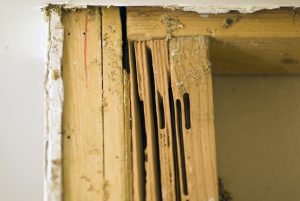 The largest ant in Ohio—as well as the nation—can be found right here in our part of the state. Ohio is home to 13 different ant species, with carpenter ants being the largest. The biggest carpenter ants (winged queens) measure up to three-quarters of an inch.
The largest ant in Ohio—as well as the nation—can be found right here in our part of the state. Ohio is home to 13 different ant species, with carpenter ants being the largest. The biggest carpenter ants (winged queens) measure up to three-quarters of an inch.
Carpenter ants eat plant and animal matter, but they can cause serious damage by chewing through wooden structures and other materials to form pathways between their nests and food sources.
Carpenter ants build two kinds of nests, a parent nest and satellite nests. From skylights to crawlspaces and everywhere in between, carpenter ants typically create nests in houses and other residential and commercial buildings. Water-damaged areas in and near window and door frames, dishwashers, chimneys, drain gutters, wooden shingles, and porches are all common spaces where carpenter ant nests are discovered.
Sometimes, satellite nests are found in dry areas within the home, like curtain rods, false beams, and under insulation in attics or crawl spaces.
 The earlier carpenter ants are detected and removed from your home, the less damage they can cause.
The earlier carpenter ants are detected and removed from your home, the less damage they can cause.
How to know you might have an infestation
These four signs could indicate you have a carpenter ant problem…
1. Wood carvings: If you notice channels appear in wood on or within your home, you may have carpenter ants. These ants chew with and against the grain of wood, and the channels they create are smooth and clean—unlike termites, which create soiled tunnels.
2. Wood shavings: If it looks a pencil sharpener was emptied within your home (and you don’t own a sharpener), it is likely the work of carpenter ants. As the ants chew and create nests, they carry the shavings out. The accumulated piles often contain leftover food and pieces of insects.

Damage by carpenter ants in a two-by-four piece of wood is evident in this exposed, interior bathroom wall.
3. Lawn disruptions: Working carpenter ants may look for food as far as 100 feet from their nest, and their trails often extend through lawns. Ants seen traveling from rotting tree stumps and leaf debris to a building are most likely foragers bringing food back to the colony. Carpenter ants can be seen on tree stumps and near piles of firewood next to the home.
4. Noise at night: Due to their large size, carpenter ants can be easily heard. You can often hear them gnawing through wood, and a large colony of carpenter ants will produce a dry, rustling sound similar to crinkling cellophane. Although these sounds can be heard at any point in the day, carpenter ants are most active at night.
To eradicate an infestation, the parent nest and all of the satellite nests must be located and removed. It can be difficult to identify the nests and know how many a colony has—especially if there are multiple colonies on the property. To completely eliminate a carpenter ant colony, the queen must be killed.
If you think you may have a carpenter ant infestation, A-1 Able Pest Doc can inspect your home and property, remove any nests found, and eliminate the colony. Call us at 1-800-737-8189 to schedule an inspection today.

Recent Comments